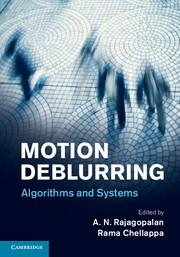Book contents
- Frontmatter
- Contents
- List of contributors
- Preface
- 1 Mathematical models and practical solvers for uniform motion deblurring
- 2 Spatially-varying image deblurring
- 3 Hybrid-imaging for motion deblurring
- 4 Efficient, blind, spatially-variant deblurring for shaken images
- 5 Removing camera shake in smartphones without hardware stabilization
- 6 Multi-sensor fusion for motion deblurring
- 7 Motion deblurring using fluttered shutter
- 8 Richardson–Lucy deblurring for scenes under a projective motion path
- 9 HDR imaging in the presence of motion blur
- 10 Compressive video sensing to tackle motion blur
- 11 Coded exposure motion deblurring for recognition
- 12 Direct recognition of motion-blurred faces
- 13 Performance limits for motion deblurring cameras
- Index
Preface
Published online by Cambridge University Press: 05 June 2014
- Frontmatter
- Contents
- List of contributors
- Preface
- 1 Mathematical models and practical solvers for uniform motion deblurring
- 2 Spatially-varying image deblurring
- 3 Hybrid-imaging for motion deblurring
- 4 Efficient, blind, spatially-variant deblurring for shaken images
- 5 Removing camera shake in smartphones without hardware stabilization
- 6 Multi-sensor fusion for motion deblurring
- 7 Motion deblurring using fluttered shutter
- 8 Richardson–Lucy deblurring for scenes under a projective motion path
- 9 HDR imaging in the presence of motion blur
- 10 Compressive video sensing to tackle motion blur
- 11 Coded exposure motion deblurring for recognition
- 12 Direct recognition of motion-blurred faces
- 13 Performance limits for motion deblurring cameras
- Index
Summary
The computer vision community is witnessing a major resurgence in the area of motion deblurring spurred by the emerging ubiquity of portable imaging devices. Rapid strides are being made in handling motion blur both algorithmically and through tailor-made hardware-assisted technologies. The main goal of this book is to ensure a timely dissemination of recent findings in this very active research area. Given the flurry of activity in the last few years in tackling uniform as well as non-uniform motion blur resulting from incidental shake in hand-held consumer cameras as well as object motion, we felt that a compilation of recent and concerted efforts for restoring images degraded by motion blur was well overdue. Since no single compendium of the kind envisaged here exists, we believe that this is an opportune time for publishing a comprehensive collection of contributed chapters by leading researchers providing in-depth coverage of recently developed methodologies with excellent supporting experiments, encompassing both algorithms and architectures.
As is well known, the main cause of motion blur is the result of averaging of intensities due to relative motion between a camera and a scene during exposure time. Motion blur is normally considered a nuisance although one must not overlook the fact that some works have used blur for creating aesthetic appeal or exploited it as a valuable cue in depth recovery and image forensics. Early works were non-blind in the sense that the motion blur kernel (i.e. the point spread function (PSF)) was assumed to be of a simple form, such as those arising from uniform camera motion, and efforts were primarily directed at designing a stable estimate for the original image.
- Type
- Chapter
- Information
- Motion DeblurringAlgorithms and Systems, pp. xi - xivPublisher: Cambridge University PressPrint publication year: 2014



